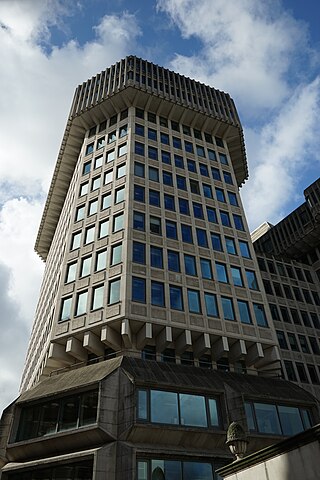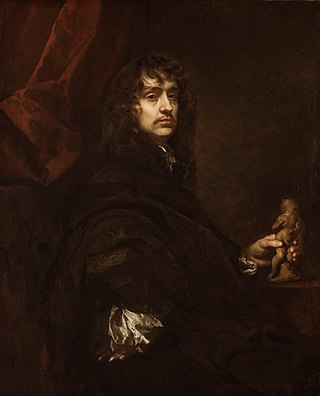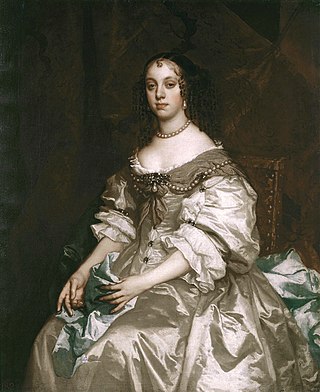Family
James Norfolk had several children:
- John (died 1675) [8]
- Martha married Hope Gifford, Councillor-at-Law of Colchester [9] [ better source needed ]
Sir James Norfolk (died 1680) was Serjeant-at-Arms to the Speaker of the House of Commons of England during the reign of Charles II. [1]
In 1656 Norfolk purchased Colchester Castle from Charles, Lord Stanhope. On Norfolk's death it passed to his son, who sold it in 1688 to a John Wheely. [2] [3]
Shortly before the return of Charles II to England and the restoration of the monarchy, ignoring those who held letters of patents for the office of Serjeant-at-Arms granted by Charles I, the House of Commons of the Convention Parliament appointed James Norfolk to the office on 25 April 1660. [4]
In January 1661 James Norfolk was instructed by the House to find the bodies of the regicides John Bradshaw, Oliver Cromwell, Henry Ireton and Thomas Pride. He located the first three corpses which were then—on 30 January 1661 (12 years to the day since the execution of Charles I)—subject to a posthumous execution: disinterred, hanged at Tyburn and beheaded. The bodies were thrown into a pit and the heads placed on spikes at the end of Westminster Hall (the building where the trial of Charles I had taken place). [5]
Norfolk was reappointed as Serjeant-at-Arms to the Speaker of the House of Commons in May 1661 with Royal consent. [1]
At the Restoration a new Mace had been commissioned but in 1670 Norfolk reported to the House that the Mace was no longer fit for service, so an order was issued to the Master of the Jewel House to have a new one made for the Serjeant-at-Arms' use. [6]
On 2 June 1675 the Speaker of the House of Commons ordered that Norfolk be apprehended and sent to the Tower of London for failure to carry out wishes of the House of Commons. However, he could not be found. His disappearance coincided with a dispute between the House of Commons and the House of Lords. The Commons had ordered Sergeant Norfolk to detain certain people overnight so that they could be brought to the bar of the House of Commons for questioning. Black Rod was ordered by the House of Lords to free the men. Black Rod had carried out his orders while Norfolk had failed to carry out his. [7]
Norfolk died and was buried in the churchyard at Romford Chapel on 18 November 1680. [8]
James Norfolk had several children:
{{cite web}}: External link in |author=
A ceremonial mace is a highly ornamented staff of metal or wood, carried before a sovereign or other high officials in civic ceremonies by a mace-bearer, intended to represent the official's authority. The mace, as used today, derives from the original mace used as a weapon. Processions often feature maces, as on parliamentary or formal academic occasions.

The Secretary of State for the Southern Department was a position in the cabinet of the government of the Kingdom of Great Britain up to 1782, when the Southern Department became the Home Office.

The Usher of the Black Rod is an official in the parliaments of several countries of the Commonwealth of Nations. The position originates in the House of Lords of the Parliament of the United Kingdom. Equivalent positions also exist in Australia, Canada, and New Zealand.

The Government Legal Department is the largest in-house legal organisation in the United Kingdom's Government Legal Profession.

Sir Harbottle Grimston, 2nd Baronet was an English lawyer and politician who sat in the House of Commons at various times between 1640 and 1685 and was Speaker in 1660. During the English Civil War he remained a Parliamentarian but was sympathetic to the Royalists.
The Office of the Lord Lieutenant was created during the reign of Henry VIII (1509–1547), taking over the military duties of the Sheriffs and control of the military forces of the Crown. From 1569 there was provision for the appointment of Deputy Lieutenants, and in 1662 the Lord-Lieutenant was given entire control of the militia. The Regulation of the Forces Act 1871 transferred this function back to the Crown, and in 1921, the office lost its power to call upon men of the County to fight in case of need. Since 1711 all the Lord Lieutenants have also been Custos Rotulorum of Devon.
This is an incomplete list of people who have served as Lord Lieutenant of Norfolk. Since 1689, all Lord Lieutenants have also been Custos Rotulorum of Norfolk.
The Apothecary to the Household is an officer of the Medical Household of the Royal Household of the Sovereign of the United Kingdom. He has a salaried daily surgery.

James Hamilton, 6th Earl of Abercorn, PC (Ire), was a Scottish and Irish peer and politician. Appointed a groom of the bedchamber to Charles II after the his father's death in battle, he took the Williamite side at the Glorious Revolution and in March 1689 supplied Derry with stores that enabled the town to sustain the Siege of Derry until it was relieved in August. Shortly after inheriting a Scottish and Irish peerage from a second cousin, he was created a viscount in Ireland for his services to the Williamite cause.

Sir Peter Lely was a painter of Dutch origin whose career was nearly all spent in England, where he became the dominant portrait painter to the court. He became a naturalised British subject and was knighted in 1679.
Sir Richard Newdigate, 1st Baronet was an English judge, landowner and politician who sat in the House of Commons from 1660.
Sir John Maynard K.B. (1592–1658) was an English politician.

The title of Principal Painter in Ordinary to the King or Queen of England or, later, Great Britain, was awarded to a number of artists, nearly all mainly portraitists. It was different from the role of Serjeant Painter, and similar to the earlier role of "King's Painter". Other painters, for example Nicholas Hilliard had similar roles with different titles. "Principal Painter in Ordinary", first used for Sir Anthony Van Dyck, became settled as the usual title with John Riley in 1689.
The Serjeant at Arms of the House of Commons is a parliamentary official responsible for order in the House of Commons. The office dates to 1415 and traditionally included responsibility for security. The role is now mainly ceremonial.
Sir Audley Mervyn of Trillick (1603?–1675) was a lawyer and politician in seventeenth-century Ireland. He was MP for County Tyrone and Speaker of the Irish House of Commons 1661–1666.
This is a list of lawyers who held the rank of serjeant-at-law at the Bar of Ireland.
Sir Edward Atkyns was an English lawyer and politician who sat in the House of Commons in 1660. He was the Chief Baron of the Exchequer from 1686 to 1689.
Sir Charles Wyndham was an English politician who served as a Whig Member of Parliament from 1679 to 1701.
Sir Philip Skippon, FRS, of Foulsham, Norfolk, Wrentham and Edwardstone, Suffolk, was an English traveller, writer, diarist, landowner and MP.
Sir Nevill Catlin (1634–1702) of Kirby Cane in Norfolk and of Wingfield Castle in Suffolk, England, was a landowner and member of Parliament from a Norfolk family long active in local and national affairs.